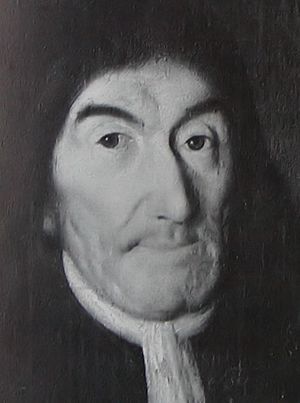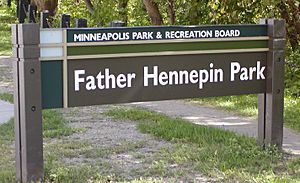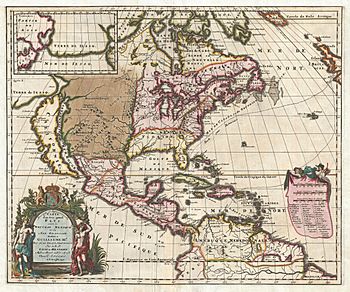Louis Hennepin facts for kids
Quick facts for kids
Louis Hennepin
|
|
|---|---|
 |
|
| Born |
Antoine Hennepin
12 May 1626 |
| Died | 5 December 1704 (aged 78) |
| Occupation | Priest, Missionary |
| Organization | Franciscan Récollets |
Father Louis Hennepin was a Roman Catholic priest and missionary. He was also an explorer of North America. He was born Antoine Hennepin on May 12, 1626, in what is now Belgium. He passed away on December 5, 1704.
Louis Hennepin's Early Life and Journeys
Antoine Hennepin was born in Ath, a town in the Spanish Netherlands. This area is now part of Belgium. In 1659, the French army captured the town of Béthune where he lived.
Hennepin joined the Franciscan religious group. He worked as a preacher in Belgium and France. Later, he managed a hospital in Maastricht. He also served briefly as a chaplain for the army.
Journey to New France
In May 1675, King Louis XIV of France asked the Récollets (a branch of the Franciscans) to send missionaries to New France. This was the name for French lands in North America. Hennepin was one of four missionaries sent. He traveled with René Robert Cavelier, Sieur de la Salle, a famous explorer.
In 1676, Hennepin went to a mission for Native Americans at Fort Frontenac. From there, he visited the Mohawks.
Exploring the West
In 1678, Hennepin was asked to join La Salle on an expedition. Their goal was to explore the western parts of New France. In 1679, Hennepin and La Salle left Quebec City. They built a large boat called Le Griffon. They planned to sail through the Great Lakes and explore the unknown western lands.
In January 1680, Hennepin was with La Salle when they built Fort Crevecoeur. This fort was near what is now Peoria, Illinois. In February, La Salle sent Hennepin and two others ahead. Their mission was to find the Mississippi River. They followed the Illinois River until it met the Mississippi.
Soon after, a Sioux war party captured Hennepin. They took him into what is now Minnesota. In September 1680, Daniel Greysolon, Sieur Du Lhut helped Hennepin and his companions. They were given canoes and allowed to leave. Eventually, they returned to Quebec.
Hennepin then went back to France. His religious order never allowed him to return to North America. Some historians believe he was the first European to step ashore at the site of present-day Hannibal, Missouri.
Discovering Waterfalls
Hennepin helped the world learn about two very important waterfalls. One was Niagara Falls, which has the most water flowing over it in North America. The other was Saint Anthony Falls in what is now Minneapolis. This is the only natural waterfall on the Mississippi River.
In 1683, Hennepin wrote a book about Niagara Falls called A New Discovery. A famous painter, Thomas Hart Benton, created a painting about Hennepin at Niagara Falls.
Books Written by Louis Hennepin
Hennepin wrote several books about his travels:
- Description de la Louisiane (Paris, 1683)
- Nouvelle découverte d'un très grand pays situé dans l'Amérique entre le Nouveau-Mexique et la mer glaciale (Utrecht, 1697)
- Nouveau voyage d'un pays plus grand que l'Europe (Utrecht, 1698)
- A New Discovery of a Vast Country in America (1903 edition)
Some historians have questioned how true Hennepin's stories are. For example, the American historian Francis Parkman doubted many of his claims.
Many historians have said that Hennepin made up parts of his stories. Some writers have tried to say that others added the wrong information to his books. But most evidence suggests that he wrote it himself.
—Catholic Encyclopedia, 1913
Places Named After Louis Hennepin
Many places in the United States and Canada are named after Louis Hennepin.
Illinois
- The city of Hennepin, Illinois
- The Hennepin Room at Starved Rock Lodge and Conference Centre in Utica, Illinois
- The Hennepin Canal
Michigan
- Point Hennepin, the northern tip of Grosse Ile, an island near Detroit
- Hennepin Street in Garden City, Michigan
- Hennepin Road in Marquette, Michigan
- The Hennepin, a ship that was the first to unload its own cargo. Its remains are west of South Haven, Michigan.
Minnesota
- Hennepin County, Minnesota, where Minneapolis is located
- Hennepin Avenue, a street in Minneapolis
- The Father Louis Hennepin Bridge, which crosses the Mississippi River in Minneapolis
- Father Hennepin State Park, in Isle, Minnesota
- The city of Champlin, Minnesota holds a festival each June. It celebrates Father Hennepin crossing the Mississippi River there in 1680.
- Hennepin Island is in the Mississippi River at St. Anthony Falls. It has a laboratory and a power plant.
- Father Hennepin Park is on the east bank of the Mississippi River. It has picnic areas and plaques about history.
- The Hennepin Room at the Minneapolis Hilton Hotel
- The Father Hennepin Memorial stands at Saint Mary's Basilica in Minneapolis.
Missouri
- Hennepin Dr, in St Louis
New York
- Hennepin Road in Grand Island, New York
- Hennepin Avenue on Cayuga Island in Niagara Falls, New York
- Hennepin Room at the Niagara Falls Conference Center
- Hennepin Park, a park in Niagara Falls, New York
- Hennepin Hall, a residence hall at Siena College
- Hennepin Park, a park in Buffalo, New York
- Hennepin Parkway, a street in Buffalo, New York
- Hennepin Farmhouse Saison Ale, a type of beer from Brewery Ommegang
Niagara Falls, Ontario (Canada)
- Father Hennepin Separate School
- An Ontario Historical Plaque at Murray Avenue and Niagara River Parkway
- Hennepin Room at Niagara Falls Marriott on the Falls Hotel
- Hennepin Crescent
See also
 In Spanish: Louis Hennepin para niños
In Spanish: Louis Hennepin para niños




